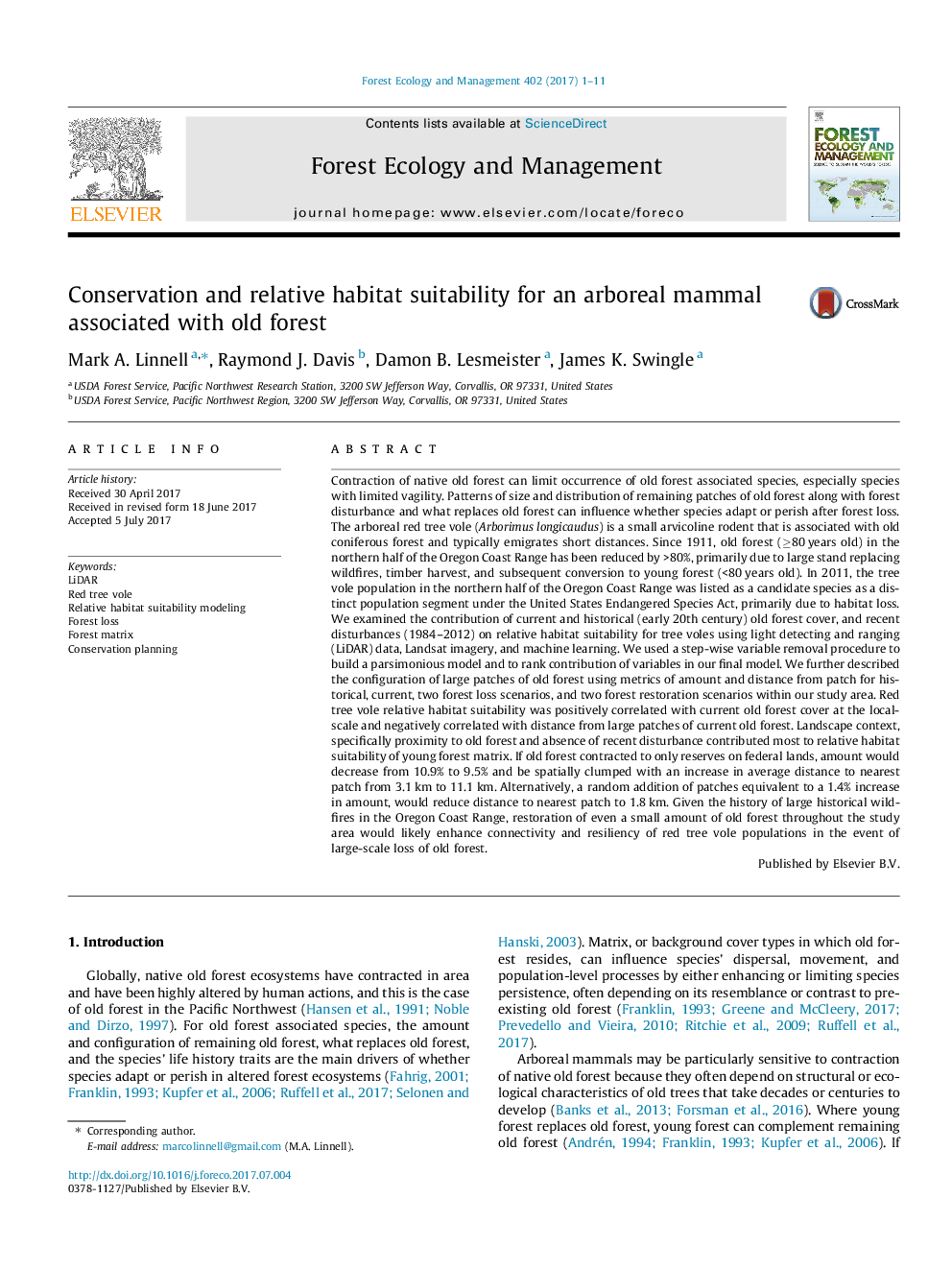| کد مقاله | کد نشریه | سال انتشار | مقاله انگلیسی | نسخه تمام متن |
|---|---|---|---|---|
| 4759335 | 1421356 | 2017 | 11 صفحه PDF | دانلود رایگان |
عنوان انگلیسی مقاله ISI
Conservation and relative habitat suitability for an arboreal mammal associated with old forest
ترجمه فارسی عنوان
حفاظت و مناسب بودن زیستگاه نسبی برای پستانداران باغی با جنگل قدیمی
دانلود مقاله + سفارش ترجمه
دانلود مقاله ISI انگلیسی
رایگان برای ایرانیان
موضوعات مرتبط
علوم زیستی و بیوفناوری
علوم کشاورزی و بیولوژیک
بوم شناسی، تکامل، رفتار و سامانه شناسی
چکیده انگلیسی
Contraction of native old forest can limit occurrence of old forest associated species, especially species with limited vagility. Patterns of size and distribution of remaining patches of old forest along with forest disturbance and what replaces old forest can influence whether species adapt or perish after forest loss. The arboreal red tree vole (Arborimus longicaudus) is a small arvicoline rodent that is associated with old coniferous forest and typically emigrates short distances. Since 1911, old forest (â¥80 years old) in the northern half of the Oregon Coast Range has been reduced by >80%, primarily due to large stand replacing wildfires, timber harvest, and subsequent conversion to young forest (<80 years old). In 2011, the tree vole population in the northern half of the Oregon Coast Range was listed as a candidate species as a distinct population segment under the United States Endangered Species Act, primarily due to habitat loss. We examined the contribution of current and historical (early 20th century) old forest cover, and recent disturbances (1984-2012) on relative habitat suitability for tree voles using light detecting and ranging (LiDAR) data, Landsat imagery, and machine learning. We used a step-wise variable removal procedure to build a parsimonious model and to rank contribution of variables in our final model. We further described the configuration of large patches of old forest using metrics of amount and distance from patch for historical, current, two forest loss scenarios, and two forest restoration scenarios within our study area. Red tree vole relative habitat suitability was positively correlated with current old forest cover at the local-scale and negatively correlated with distance from large patches of current old forest. Landscape context, specifically proximity to old forest and absence of recent disturbance contributed most to relative habitat suitability of young forest matrix. If old forest contracted to only reserves on federal lands, amount would decrease from 10.9% to 9.5% and be spatially clumped with an increase in average distance to nearest patch from 3.1 km to 11.1 km. Alternatively, a random addition of patches equivalent to a 1.4% increase in amount, would reduce distance to nearest patch to 1.8 km. Given the history of large historical wildfires in the Oregon Coast Range, restoration of even a small amount of old forest throughout the study area would likely enhance connectivity and resiliency of red tree vole populations in the event of large-scale loss of old forest.
ناشر
Database: Elsevier - ScienceDirect (ساینس دایرکت)
Journal: Forest Ecology and Management - Volume 402, 15 October 2017, Pages 1-11
Journal: Forest Ecology and Management - Volume 402, 15 October 2017, Pages 1-11
نویسندگان
Mark A. Linnell, Raymond J. Davis, Damon B. Lesmeister, James K. Swingle,
